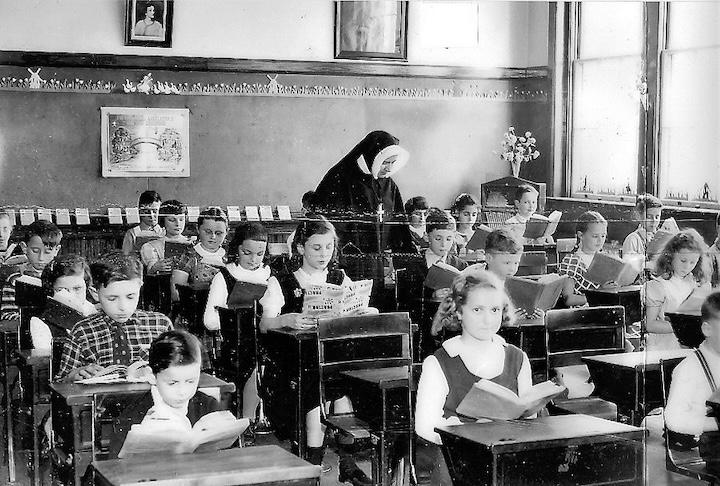From January 28 through February 3, the Church in the United States is observing the annual Catholic Schools Week. It’s significant that almost every American saint was involved in Catholic education, starting with St. Elizabeth Ann Seton and St. John Neumann.
“The days have come. . .in which the school is more necessary than the church,” declared New York’s Archbishop John J. Hughes over 150 years ago, who felt that, if he lost the children, there would be little hope for the future of the Church in this country.
In 1884 at the Third Plenary Council of Baltimore, the bishops of our nation proclaimed: “We decide and decree that near each church, where it does not exist, a parish school is to be erected within two years of the promulgation of this Council.” The rationale behind this first-of-its-kind legislation in the history of the Church lay in Pope Pius XI’s encyclical, Divini Illius Magistri (On the Christian Education of Youth):
The so-called “neutral” school from which religion is excluded, is contrary to the fundamental principles of education. Such a school moreover cannot exist in practice; it is bound to become irreligious.
The American “public” school system is a textbook case of a religiously “neutral” system becoming hostile to religion.
St. John Paul II declared in his 1979 address to the National Catholic Educational Association: “Yes, the Catholic school must remain a privileged means of Catholic education in America. . . worthy of the greatest sacrifices.” He likewise referred to the Catholic school as “the heart of the Church.”
We need to revive what I like to call “The Spirit of 1884,” in which the bishops of our nation issued that clarion call to have every Catholic child in a Catholic school. Only in that way, shall we stave off the emergence of another generation growing up “according to the standards of a civilization of hyenas,” as Thomas Merton put it.
At times, one hears: “Yes, the Catholic schools were great in the good old days. But not anymore.” People saying that probably got badly burnt in the nutty sixties and seventies. They need to visit their local Catholic school today. The “market economy” took care of most of the bad Catholic schools; no one in his right mind is going to spend thousands of dollars on a public school with a crucifix. Hence, the popularity of the Catholic identity assessment we offer through the Catholic Education Foundation.
With the near-total abandonment of the school apostolate by women religious in the 1970s, we also have to be seriously intentional about the formation of lay faculty and administrators. I have fashioned a program through Pontifex University leading to a master’s and doctoral degree in Catholic school administration.

The involvement of priests is crucial. Every study has shown that the vitality of a school is in direct proportion to the support of both bishops and priests.
And we cannot overstate the centrality of parents. More and more schools are discovering that they have to provide direction to this generation of parents who, regrettably, were all too often not properly “parented” themselves.
While not a few parents choose Catholic schools for the academics and discipline more than for the faith, pastors and principals regularly report that many such parents eventually have their marriages convalidated and begin to lead a sacramental life due to the influence of their children.
Of course, this is exactly what the American bishops of the nineteenth century foresaw.
The big elephant in the ecclesial room is the cost of Catholic schools. We cannot be academies for the wealthy; that’s not our tradition. It’s a tribute to the commitment of our parents that so many of them sacrifice for the Catholic education of their children.
Yet at the same time, many of the institutions built by penniless immigrants seemingly cannot be sustained by the most affluent Catholic population in the history of the Church. Our problem is not finance but faith. Priorities are way off.
But we also need to move beyond the tuition-based model. The Code of Canon Law is quite clear that the burden of supporting Catholic schools is the responsibility of the entire Catholic community, not simply parents with children. Thinking “outside the box” is necessary. The Diocese of Wichita has been a leader in this regard for decades, offering free Catholic education, K through 12.
And we need to acknowledge that even the best-intentioned out-of-school programs of religious education have failed. Indeed, the glory of the Church in America before the Second Vatican Council was our unique system of Catholic schools, which still produces the vast majority of observant adult Catholics, as well as the majority of vocations to the priesthood and consecrated life.
St. John Henry Newman, well known for his commitment to university education, is less well known for his devotion to Catholic education at the lower levels. Indeed, he saw that Catholic education at the higher level needs Catholic education at the lower levels, which led to his establishment of “the apple of his eye,” The Oratory School.
So strong was Newman’s advocacy on behalf of Catholic schools, that in 1879 the Archbishop of Sydney, Roger Bede Vaughan, solicited his assistance for the cause in Australia. To which the newly minted Cardinal replied:
It is indeed the gravest of questions whether our people are to commence life with or without adequate instruction in those all-important truths that ought to colour all thought and to direct all action; – whether they are or are not to accept this visible world for their God and their all, its teaching as their only truth, and its prizes as their highest aims; – for, if they do not gain, when young, that sacred knowledge which comes to us from Revelation, when will they acquire it?
Yes, indeed, “if they do not gain, when young, that sacred knowledge which comes to us from Revelation, when will they acquire it?”















